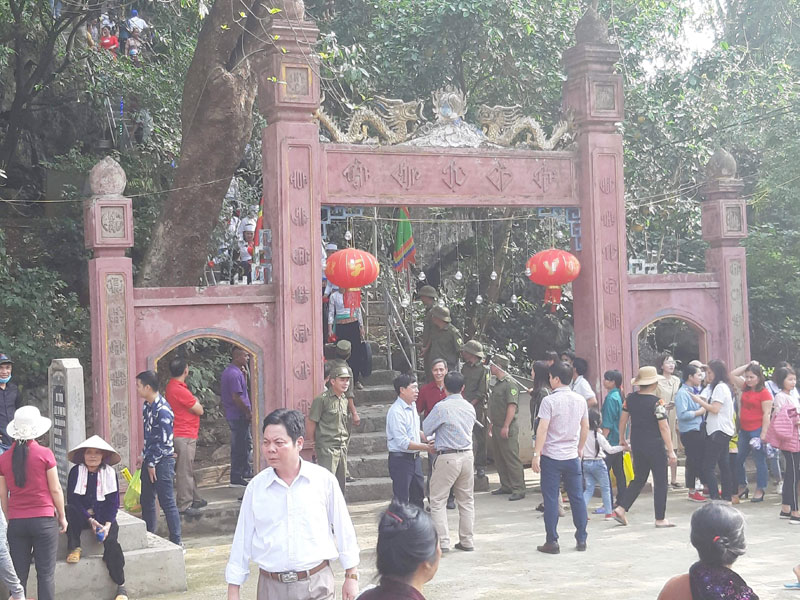
(HBO) – After restoration, Hang (Cave) Pagoda in Yen Tri commune of Hoa Binh province’s Yen Thuy district still has the unique architectural features of a pagoda in a cave maintained while the landscape improved.
 The special feature of the Hang Pagoda in Yen Tri
commune (Yen Thuy district) is that its entire space of worship is located
inside a cave.
The special feature of the Hang Pagoda in Yen Tri
commune (Yen Thuy district) is that its entire space of worship is located
inside a cave.
Hang Pagoda is the common name of a Buddhist
temple built in Hang Chua (Pagoda Cave), also known as Van Quang Cave. In the
past, it has the courtesy name of Thanh Lam Tu.
The pagoda and the cave accommodating it are
about 85km to the south of the centre of Hoa Binh city, 5km away from Hang Tram
town, and 13km from Nho Quan town of neighbouring Ninh Binh province.
The cave was named Hang Chua (Pagoda Cave) since
two of the four caverns in the mountain house pagodas. The caverns are
decorated with not only the temples’ architecture but also poems and texts
engraved on their stone walls.
Archaeologists also discovered traces of the Hoa
Binh civilisation in Hang Chua such as food vestiges like snail and clam shells
and tool fragments.
Not only the architectural features but the
landscape full of greenery here also makes this place special.
In 1994, the site of Hang Pagoda and Chua Cave
was recognised as a national historical and cultural relic site by the Ministry
of Culture. Since then, the Hang Pagoda festival has been organised at the
beginning of every year, offering an occasion for visitors to admire the unique
pagoda landscape, pray for wealth, and join locals in folk cultural activities.
In 2020, some of the site’s facilities were restored
and built so as to help preserve and bring into play the site’s value./.
Xoe dance, an unique art form of the Thai ethnic minority group in Mai Chau district of Hoa Binh province has existed for a long time and passed down through generations. Xoe dance is not only a popular dance in the Thai community but also a unique cultural feature, an indispensable part in the Thai ethnic minority people's cultural and spiritual life.
The Bac Son pre-school in Hung Son commune, Kim Boi district is effectively implementing a model of preserving and promoting cultural identity of the Muong ethnic group.
Through ups and downs, many unique cultural features of the Muong ethnic minority group are facing risks of falling into oblivion. However, with a strong determination, Lac Son district of Hoa Binh province has deployed synchronous solutions to preserve and promote the locality's cultural heritage values.
If Tan Lac is considered the core of the cradle of Muong culture in Hoa Binh, Phong Phu commune is the cultural centre of Muong culture in Tan Lac district. Luy Ai hamlet in Phong Phu commune is where customs and traditions of Muong Bi are preserved. Luy Ai hamlet was chosen to build a space to preserve Muong ethnic culture. The district is seeking support from the province and coordinating with relevant agencies to devise a plan on preservation of Muong cultural spaces associated with developing tourism products and improving the lives of local residents.
Nguyen Manh Tuan, a Muong ethnic man in Ba Hang Doi town, Lac Thuy district, is known as a young, dedicated, and outstanding artisan who has made significant contributions in collecting, restoring, and preserving national cultural values.
The Government Office with Document No. 2082/VPCP-KGVX, dated March 29, 2024, sent out the opinion of Deputy Prime Minister Tran Hong Ha regarding the submission of the "Mo Muong" and "Cheo art" dossiers to the United Nations Educational, Scientific and Cultural Organization (UNESCO).



 The special feature of the Hang Pagoda in Yen Tri
commune (Yen Thuy district) is that its entire space of worship is located
inside a cave.
The special feature of the Hang Pagoda in Yen Tri
commune (Yen Thuy district) is that its entire space of worship is located
inside a cave.